Crowns
A Crown is a “tooth shaped” cap that is put over a tooth to restore its shape, size, strength and appearance. A crown treatment describes a dental procedure where the whole of the tooth except the root is restored. If performed well, Crowns last for much longer than a normal filling and are the strongest possible solution for damaged teeth. Crowns can be made to look and feel like natural teeth and recommended when there is considerable structural damage to a tooth.Crowns are also recommended when the damage to tooth is so extensive that other treatments options are not viable/adequate. The common reason for extensive damage of teeth is usually due to either decay, trauma, cracks or wear and tear.
Full Metal Crowns
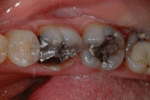
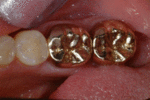
Non-Metal Crowns
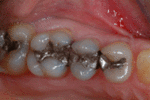
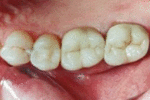
Dental Bridges
A dental bridge is a viable alternative to replacing missing teeth that involves having an artificial tooth supported by surrounding natural teeth. Usually a dental bridge consists of two crowns on either side with one or more false teeth in the middle.
Traditional Bridges, Cantilever Dental Bridges and Maryland Bridges are the common types of bridges used in the industry. A traditional bridge involves having crowns on each tooth, adjacent (or either side) to the missing teeth. A cantilever bridge involves supporting the false teeth using just the one adjacent crowned tooth.
The process of making a Bridge involves taking an impression/mould from your dentist, which is then sent to a dental technician. A temporary bridge is also then cemented in place. The dental technician then hand crafts the permanent dental bridge in the lab, usually using porcelain and/or metal core.The bridge is then placed into your mouth by the dentist and adjustments are made if needed, to ensure a proper fit
Tooth Colour Restoration
A dental bridge is a viable alternative to replacing missing teeth that involves having an artificial tooth supported by surrounding natural teeth. Usually a dental bridge consists of two crowns on either side with one or more false teeth in the middle.
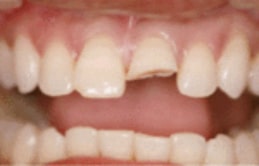
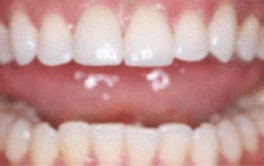
Traditional Bridges, Cantilever Dental Bridges and Maryland Bridges are the common types of bridges used in the industry. A traditional bridge involves having crowns on each tooth, adjacent (or either side) to the missing teeth. A cantilever bridge involves supporting the false teeth using just the one adjacent crowned tooth.
The process of making a Bridge involves taking an impression/mould from your dentist, which is then sent to a dental technician. A temporary bridge is also then cemented in place. The dental technician then hand crafts the permanent dental bridge in the lab, usually using porcelain and/or metal core.The bridge is then placed into your mouth by the dentist and adjustments are made if needed, to ensure a proper fit
Veneers
Veneers are a thin semi-translucent “shells” of medical grade ceramic that is permanently bonded to your teeth. Veneers are known to be extremely strong and wear resistant. Veneers can help achieve a pleasant natural look with little or no discomfort. The veneer procedure involves removing a very small amount of tooth structure and placing these thin shells over to cover the tooth – much like putting on false fingernails. A common pre-requisite or requirement for porcelain veneers is the need for your gums to be healthy, as this facilitates the dentist to obtain an accurate fit for the veneer at the gum line. Porcelain veneers can significantly improve the appearance and colour of discoloured or chipped teeth..
At Southland Dental, we now offer the latest advancement in veneers known as UVeneer – a unique, innovative template system that creates polished composite veneers. This is a new state of the art technology that employs minimally invasive dentistry while offering an opportunity for patients to gain that perfect smile.
Implant Restoration
A dental implant is a surgical component titanium “screw” that resembles a tooth root and is placed within the jawbone to support restorations and replace missing teeth. Over time, the implant fuses with the surrounding bone and function in a similar way to natural teeth. The missing teeth restored with dental implants might feel slightly different from natural teeth during chewing as implants may lack the periodontal ligament.
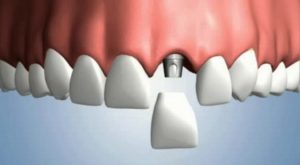
Dental implants are used to support a number of dental prostheses, including crowns, implant-supported bridges or dentures. They can also be used as anchorage to allow tooth movement during orthodontic treatment.
Fillings
Fillings are the most common type of ‘restorative treatment’. A filling replaces the part of the tooth that has been either lost due to (a) decay causing a cavity in the tooth or (b) tooth getting broken. The widely used option to restore a tooth is to have a white filling, also commonly known as ‘Composite Filling’.
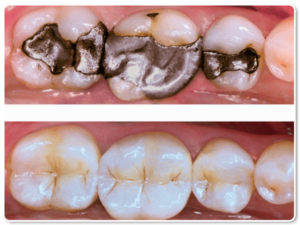 Most people have fillings on their teeth, which involve having grey metal called ‘Amalgam’ fillings. Many patients no longer have the desire for Amalgam fillings due to the dark colour of Amalgam. Patients are increasingly getting practical and intent on having aesthetically pleasing fillings and thus avoiding amalgam fillings due to their dark appearance: with most white fillings, no-one would know it is there.
Most people have fillings on their teeth, which involve having grey metal called ‘Amalgam’ fillings. Many patients no longer have the desire for Amalgam fillings due to the dark colour of Amalgam. Patients are increasingly getting practical and intent on having aesthetically pleasing fillings and thus avoiding amalgam fillings due to their dark appearance: with most white fillings, no-one would know it is there.
Composites
- Repairing chipped or broken teeth
- Closing gaps between teeth
- Reshaping teeth




